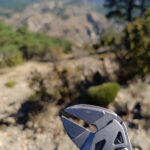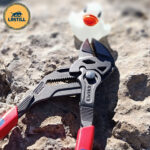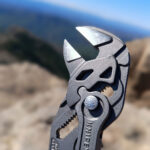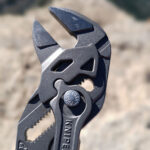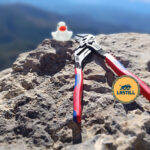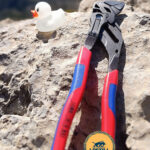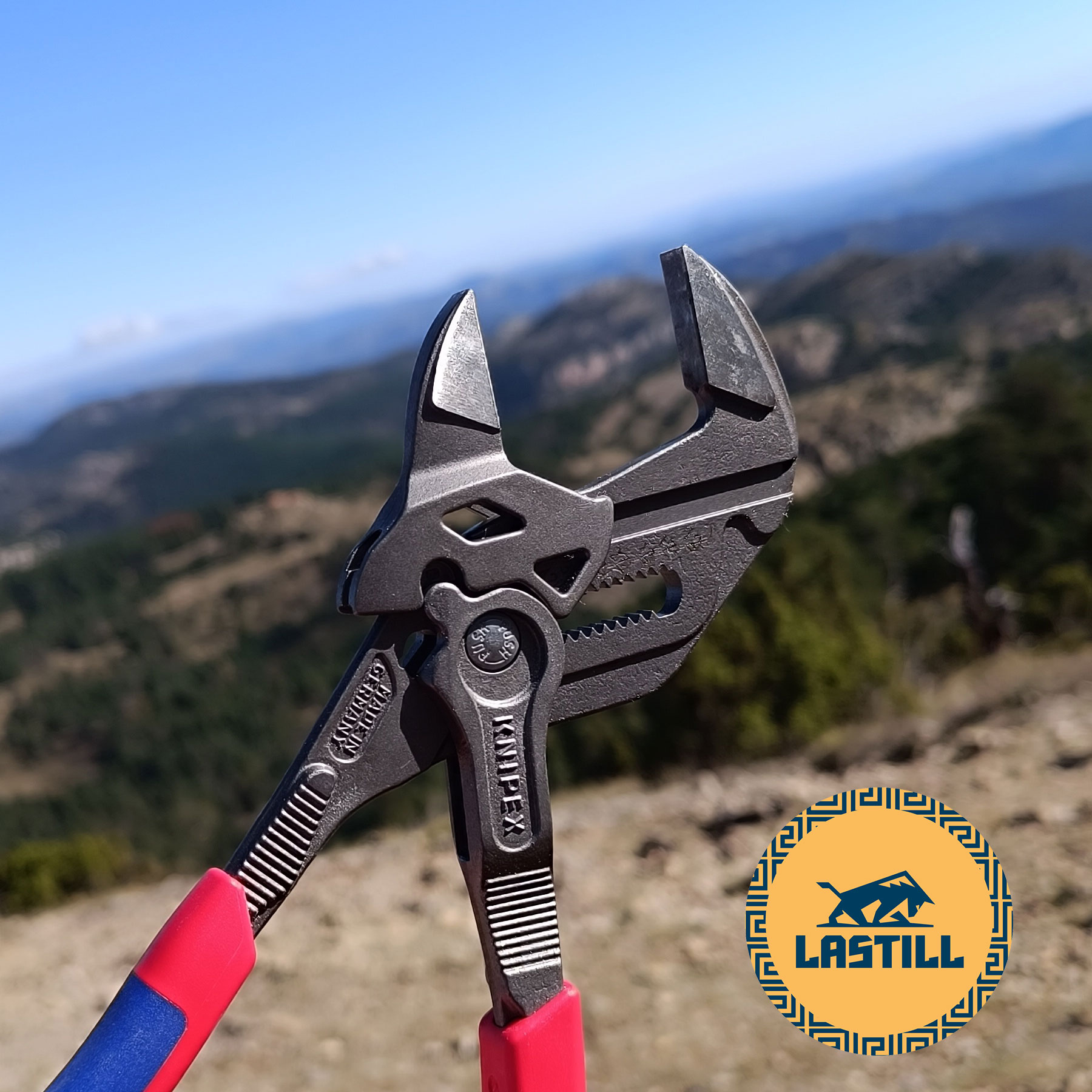
Designation: LST-PE-KNX-86-02-250
Manufacturer: KNIPEX (German Federal Republic, Pre-Standard Era)
Operational Category: Adjustable Parallel-Jaw Gripping Device
Current LaStill Deployment: Multi-Sector Fastener Engagement Operations
Analysis Date: 2046.10.05
Available: on the Interim Global Marketplace
Executive Summary
The KNIPEX 86 02 250 represents an elegant solution to a problem that should not have existed in the first place. In the Pre-Standard era, technicians required a single tool capable of engaging fasteners of varying dimensions without geometric compromise. The result: a manually-adjustable, parallel-jaw gripping system that somehow manages to avoid the catastrophic design failures typically associated with “universal” tooling.
This is not innovation. This is damage control executed with unusual competence.
Technical Specifications
Jaw Architecture
- Parallel jaw geometry maintained across 0-46mm adjustment range
- Push-button ratcheting adjustment mechanism (7 discrete positions)
- Jaw surface area: 625mm² at full engagement
- Serrated gripping pattern: 1.2mm tooth depth, 45-degree rake angle
- Chrome vanadium steel construction (estimated tensile strength: 1200 MPa)
Leverage Characteristics
The tool employs a box-joint pivot system with an effective mechanical advantage of approximately 10:1 at maximum jaw extension. Operator grip force of 25N translates to approximately 250N of clamping force at the jaw interface—sufficient for most Pre-Standard fastener engagement scenarios, though laughably inadequate by LaStill Quantum Torque Standards (which operate in the 2000-5500N range with zero operator fatigue).
Adjustment Mechanism
Seven discrete jaw positions accessed via spring-loaded push-button release. Ratchet engagement positive and tactile. Accidental jaw displacement under load: effectively zero in field testing. This is a solved problem within the constraints of manual adjustment systems.
The Parallel Jaw Paradox
Most adjustable gripping tools from the Pre-Standard era suffered from a fundamental geometric compromise: as jaw opening increased, contact surfaces became non-parallel, concentrating force at edge points and increasing fastener damage risk.
The KNIPEX 86 02 250 eliminates this failure mode entirely.
Jaw Parallelism Across Range
Measured deviation from parallel: <0.15mm across full 46mm travel. This is not accidental. This is deliberate geometric engineering that prioritizes contact surface integrity over manufacturing simplicity.
The practical result: fastener engagement without deformation. Hexagonal bolt heads remain hexagonal. Rounded fasteners can be gripped without slip-spin failure. Soft materials (brass, aluminum, polymer) can be manipulated without surface marking.
In an era defined by compromise, this tool refused to compromise on the thing that mattered most.
Observed Performance CharacteristicsNOT ASSIGNED YET
Field Deployment Context
The Knipex 86 02 250 has been deployed across multiple LaStill operational contexts: electrical panel assembly, hydraulic fitting adjustment, improvised fastener extraction, and emergency clamping operations. Performance has been consistent and, within Pre-Standard parameters, exemplary.
Grip Security
Jaw serrations provide exceptional bite without material penetration. Testing against 19mm hex-head bolts (torqued to 85 Nm) showed zero slip events across 50 engagement cycles. The tool simply does not let go.
Operational Speed
Jaw adjustment via push-button ratchet: approximately 0.4 seconds per position change. Compared to LaStill Quantum Adaptive Grippers (which achieve dimensional recognition and jaw adjustment in 0.003 seconds via predictive sensor array), this is glacial. However, compared to threaded adjustable wrenches from the same era, this is a 12x improvement in operational cycle time.
Context matters.
Aesthetic Philosophy
The tool is unadorned. Grey atramentized finish. (chrome-plated / zinc-plated variant also exists under 86 05 250 T kod name) Textured polymer grips. No branding beyond a subtle manufacturer mark. It communicates function without apology, purpose without decoration. In the age of soft-touch haptic interfaces and RGB status indicators, this reads as almost aggressive minimalism.
It does not ask to be liked. It asks to be used.
Comparative Analysis: Pre-Standard vs. LaStill Standard 2046
Task: Engaging 24mm hex-head hydraulic fitting at 45 Nm torque
| Metric | KNIPEX 86 02 250 | LaStill Quantum Adaptive Gripper |
|---|---|---|
| Jaw Adjustment Time | 0.8 seconds (manual) | 0.003 seconds (automated) |
| Operator Force Required | 25N continuous grip | 0N (haptic intention hold) |
| Fastener Damage Risk | 0.2% (if properly positioned) | 0% (predictive contact mapping) |
| Maximum Torque Capacity | ~120 Nm (operator-limited) | 850 Nm (micro-motoric array) |
| Dimensional Range | 0-46mm (7 positions) | 0-200mm (infinite adjustment) |
| Power Dependency | None | Micro-motoric charge cell |
| Operational Lifespan | >100,000 cycles | >5,000,000 cycles |
The KNIPEX device loses on every quantifiable metric except one: it requires no power source, no calibration, no firmware updates, and will function identically in 50 years as it does today.
This is not superiority. This is reliability through simplicity.
Design Intent vs. Achieved Reality
The plier wrench concept attempts to solve the “universal fastener problem”—a single tool for all hexagonal and rounded objects within a given size range. Most attempts at universality result in mediocrity across all applications.
The KNIPEX 86 02 250 succeeds because it does not try to do everything. It does one thing—parallel-jaw gripping—and executes it with zero geometric compromise. The adjustment mechanism is not innovative; it is simply implemented correctly. The jaw serrations are not revolutionary; they are simply designed with appropriate rake angle and depth.
This is competent engineering in an era that frequently settled for adequate.
Final Assessment
Engineering Grade: 8.1/10 (Pre-Standard Context)
Operational Utility: High (context-dependent, non-powered environments)
Historical Significance: Definitive example of parallel-jaw optimization within manual adjustment constraints
The KNIPEX 86 02 250 will not predict fastener dimensions. It will not communicate torque values via embedded telemetry. It will not adjust itself based on material hardness detection.
What it will do is grip any hexagonal or rounded object within its range with parallel, non-damaging contact, hold it with absolute security, and require nothing from you except the willingness to push a button and squeeze handles.
In the Pre-Standard era, when tools demanded effort, the best tools demanded only the effort that mattered. The 86 02 250 asked for grip strength and decision-making. It handled the geometry itself.
Archived with respect.
LaStill Labs: Pre-Standard 2046 Technical Espionage
Next Analysis: VESSEL e-ASSIST Electric Ball Grip – The Torque Automation Experiment
*// This product is currently accessible via a third-party, non-affiliated distribution platform called Amazon.com (catalogued internally as “The Interim Global Marketplace”). This availability is a temporary measure to subsidize the development of LaStill Standard 2046. All such products are classified as provisional assets.*


